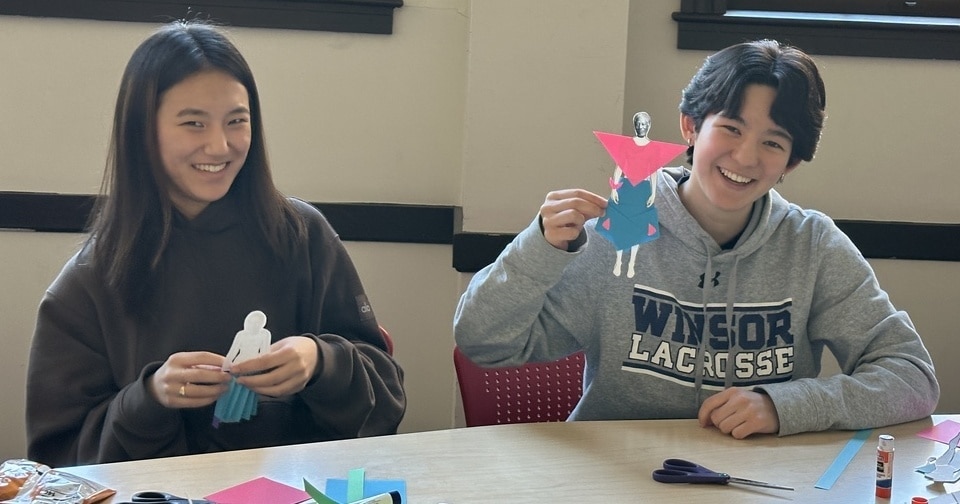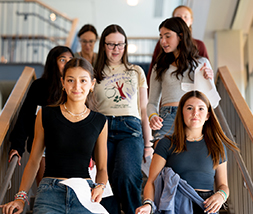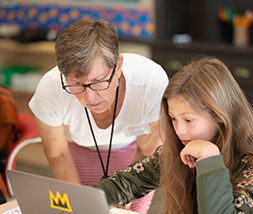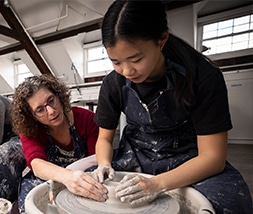Zero-Waste Fashion Inspired by Indigenous Traditions
Carlos Villamil, an associate professor of industrial design at Wentworth Institute of Technology, came to campus for a guest lecture and workshop with students in Señora Gabriella Gangi’s Senior Seminar in Spanish. Students learned about zero-waste fashion, environmentally responsible design, and the indigenous cultures that have been on the cutting edge of such practices for centuries.
“During the spring semester, students continue the exploration of social justice by focusing on the challenges posed by climate change and the United Nations 2030 Agenda for Sustainable Development,” explained Sra. Gangi. As a culmination of their work in Senior Seminar, students use the design thinking model for a final project that offers solutions for real-world problems.
Speaking entirely in Spanish and using his life’s work as a canvas, Mr. Villamil spoke with students about design inspiration, sketching, experimentation, innovation, as well as following their interests. “The chairs you’re sitting on are an example of industrial design,” he told students by way of explaining his line of work.
Mr. Villamil studied in Colombia in the ’90s and got his start designing jewelry—rings, necklaces, bracelets, and cufflinks. Coming to the United States, he worked on large-scale aisle displays, graphics, and posters for Whole Foods. After attending graduate school just down the road at MASSART, work took him to Spain where he designed shoes for luxury brands like Adolfo Dominguez. Perhaps because of the inherent waste in such designs, he became interested in the concept of zero waste and designed several clothing collections on this theme.
Mr. Villamil walked students through his design process of using industrial waste—like pieces of felt from sound insulation products—to build dresses from scraps like circles, squares, or strips of fabric. In another collection, in collaboration with a scientist at MIT, he expanded on this idea to develop a line of zero-waste unisex multifunctional clothing systems. Inspired by how cells adapt to the structure they grow in, clothes were built to transform and reverse. They won first place in the DESCIENCE competition in 2014 for their work.
Students had a chance to try their hand at their own low-waste designs using paper dolls—which playfully had celebrity faces such as Chappell Roan, Ice Spice, Audrey Hepburn, Mr. Rogers, and Morgan Freeman—and pieces of colorful paper, glue, and tape, but no scissors. Inspired by the work of Carla Fernández—renowned Mexican fashion designer who had an exhibit at the Isabella Stewart Gardner Museum last year (October 2023–February 2024)—students used her techniques for a nearly zero-waste approach. Her designs are founded on the principle of using entire pieces of cloth, resulting in minimal cuts or scraps of fabric. She prefers geometric garments that join squares and rectangles together.
We have much to learn from indigenous practices, grounded in geometry and rectangular woven fabrics. When whole pieces of fabric are used, clothing options feature boxy blouses, pointed ponchos, and skirts that rely on creative draping and wrapping of fabric—not cutting—to achieve different styles. This is true of many ancient civilizations, and Mr. Villamil was quick to point out that clothing styles like the Japanese kimono rely on the same fabric theories. “In a way, you’re constructing clothes from legos,” said Mr. Villamil of the fabric building blocks. He added, “The beauty in this form is that there isn’t one way to wear it and there isn’t an inherent gender in the clothing.”
This “slow fashion” is a change from the modern shopping experience. From the Isabella Stewart Gardner website, “Fernández works creatively with over 187 artisans from sixteen states in Mexico. Her fashion house advocates for textiles as the fabric of civilization. Fernández explores the squares and rectangles of traditional Mexican patterning for the loom and sustains long-standing creative partnerships with artisans, who preserve the rich cultural heritage of Mexico’s indigenous communities.”
As a special treat, Sra. Gangi brought in queso (cheese) and arepa de choclo (a sweet corn cake), a Colombian treat. Students noshed as they experimented and got Mr. Villamil’s input on their paper doll designs.
“I love to talk to students about the concept of designing their own life,” he said, showing students a mind map looking at things he’s done, things he wants to do, along with the intersection of friends and family.
Now at Wentworth, Mr. Villamil teaches Industrial Design Studios for all levels, Drawing, Color & Composition, Visual Communication, Information Architecture, Research Studies, and Senior Studies. Using videos and slides to show photos, sketches, and clothing patterns, Mr. Villamil explained some of the designs his Wentworth student’s create for classwork, giving Winsor students a window into what further study in industrial design might look like in college.






